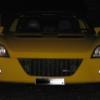
Vx220 Development Story
#1

Posted 05 September 2003 - 01:19 PM
#2

Posted 05 September 2003 - 01:26 PM
#3

Posted 05 September 2003 - 01:34 PM
#4

Posted 05 September 2003 - 01:54 PM
No they don't. Unless you speak VERY nicely to your dealer - thanks Tony...and the coffee table book that you get when you buy one new (do Vauxhall still do this?)...
James
#5

Posted 05 September 2003 - 02:31 PM
#6

Posted 05 September 2003 - 02:39 PM
#7

Posted 05 September 2003 - 02:41 PM
#8

Posted 05 September 2003 - 03:09 PM
#9

Posted 05 September 2003 - 04:00 PM
#10

Posted 05 September 2003 - 04:12 PM
#11

Posted 05 September 2003 - 11:56 PM
A German TV car programme ran a whole programme about the development of the Speedster showing how it was the project of a female Opel engineer. I met and talked with her at the above meeting and she said they were obviously liasing a lot with Lotus, but Opel determined the specification.
In the book "Elise, Rebirth of the true Lotus"
by Alastair Clements first published 2003, ISBN 1 85960 857 4 Price £19.99
in chapter 5 "Variations on a theme" he writes,
"Lotus by another name
Versatility is a word that continues to reappear when referring to Richard Rackham's innovative Elise chassis design and it was a feature that was to rear its head again at the Geneva Motor Show in March 1999. On the Opel stand sat a dynamic new two-seat roadster, with angular and aggressive styling by General Motors's design director Martin Smith and with remarkably similar dimensions to the Lotus Elise. The reason soon became clear. The Opel Speedster was a collaboration between GM and Lotus, mating a modified version of the extruded and bonded Elise chassis to the Astra Coupé's all-aluminium 2,198cc 16-valve Ecotec "four" in an effort to boost the brand appeal of GM's staid Opel and Vauxhall marques. "We've worked with them before and in effect they wanted a piece of Lotus," explained Gavan Kershaw, who worked with the engineers from Vauxhall in developing the car, tagged VX220 in the UK. "They can't understand why people buy Lotuses, but they realised it was exactly what their brand needed. They needed a sports car, for Germany especially, to gve the brand some hype".
There was also assistance from Lotus Design to productionise the GM concept and at the 1999 Earls Court Motor Show, Lotus announced that they would build 2,000 Opel Speedsters and 1,000 Vauxhall VX220s annually at Hethel. "We were making Elises on quite a small production line," said Kershaw, "then someone sat down and said "we want to build 3,000 of these things as well", which means we've got to build a whole new factory with a capability of building 6-10,000 cars per year." Given the codename Skipton by the factory, the GM car was far more than just an Elise with a makeover, as Kershaw explained: "We're looking at 10 per cent carry-over components between the two: fixings, radiators, indicator stalks and stuff like that. And that's fine because it doesn't interfere with how the car drives, it's got a different interior and it drives differently."
Although based on an Elise tub, with the sills cut down by 50mm for easier access, the Vauxhall boasted a longer wheelbase, a wider track, particularly at the rear to accommodate the beefier new motor, and larger overall dimensions meaning it was never likely to be quite as agile. It was also substantially heavier at 875kg (1,929lbs), but there was superbly direct steering and a similar double wishbone set-up giving the expected excellent ride/handling compromise, if a little softer. But with new Bilstein dampers, wider rear track and the skinny 175-section front tyres adorning those hefty 17in alloys, there was the safe mild understeer expected of a Vauxhall model. A standard servo and anti-lock system were sensible additions to the brakes, boosting both comfort and safety. However, the new car's trump card was its engine, with a useful 145bhp at 5,800rpm and a massive – in Elise terms – 150lb ft (203Nm) of torque at 4,000rpm from a totally unstressed unit. Power was delivered via a slick Getrag five-speed gearbox, but despite the extra grunt the Vauxhall's weight meant both its economy and performance lagged behind its Lotus sibling, with 0-60mph reached in 6.1 seconds, although the extra torque boosted top speed to 132mph (212km/h).
The Lotus ride and handling enghineers, assisting representatives from Vauxhall, were able to ensure that the VX220 behaved differently enough to the Elise to ensure there was a marketplace for both cars. "There was a reasonable amount of input from Lotus Engineering," Kershaw admitted, "they've set their car up for the way they want an Opel or Vauxhall to drive. I don't think they wanted an Elise, they've got a totally different customer range to us." Kershaw rates the Elise and VX220 as horses for courses: "In certain circumstances and on certain days of the week I do enjoy how the VX drivest. IT is a typical large capacity, very torquey unit and there are days of the week when everyone cries out for a car like that. And then other times, when you get to blast around a B-road or a track, you want to be at maximum rpm."
The GM car's sharp-suited glassfibre body has a bulkier look with some great details such as the neat rear lights or the up-and-over tailpipes, but the Elise bloodline remains obvious, with innovative details including making the exhaust silencer part of the rear crash structure. The vuaxhall VX220 was a little less attractive to buyers than the near-identical Opel Speedster, thanks to an uninspiring name and less pleasing grille and badging.
But it was inside that a VX might have tempted potential Elise buyers away from a Lotus showroom and into a Vauxhall one. There was more comfort, a few more toys – it was a bit more Vauxhall. There was still lots of exposed aluminium, including a stylish optional extruded aluminium brace bar, but there was a conventional dashboard, albeit with a set of Stack instruments and a starter button mounted in the centre. In addition to the cut-down sills, longer doors aided entry and exit, although it was still not the most gracefuln operation, and there was sound deadening injected into the body cavities to add refinement. The driving position would be familiar to Elise owners, but gone were Richard Rackham's lovely extruded pedals, although their drilled replacements were not unattractive, and ahead sat a tiny Momo wheel, the smallest ever to come complete with airbag. To add a bit of practicality there was a more user-friendly and watertight hood and a bigger boot. And the price for this extra power and comfort? Just £320 more than a basic Elise with a launch price tag of £22,995 plus £1,200 for a stylish optional hardtop.
The VX220 suffered from something of an image problem, in the UK at least,seen as a poor relation to the Lotus that sired it, a dilution of the purity of the original, or worse, a cynical cashing-in on the Elise success. It was a situation that wasn't helped by Vauxhall launching the car with a disastrous advertising campaign featuring comedian Griff Rhys-Jones clad in ginger beard, vest and Y-fronts to explain that the VX was the sexiest Vauxhall ever built. Cheap images of it toddling round the military test track at Chobham, Surrey, and Rhys-Jones's irritating voice-overs did little to endear the new model with an already sceptical buying public. The press acclaimed the new car however, praising its mixture of friendlier Elise handling, torquey engine and improved interior, with What Car? presenting the Vauxhall with "Best Roadster" in its Car of the Year Awards for both 2001 and 2002.
Channel 4's "Driven" television programme pitted a VX220 against its blood brother when the Elise Series 2 arrived (see Chapter 6) and found the Vauxhall the mor epractical car with a bigger boot and an easier and more leak-resistant hood. Former rally ace Penny Mallory commented: "Inside it's got a lot more creature comforts, and of course that lovely 2.2-litre Vauxhall engine". Mallory raised a point that a lot of enthusiasts will undoubtedly have asked themselves: "It's so similar to the Elise it could have been cloned, it does make you wonder if Lotus haven't shot themselves in the foot by selling their best trade secrets to a direct competitor". Driven found the Vauxhall to be brilliant fun to drive and controllable on the limit, but Mallory highlighted the car's biggest disability: "Ultimately, a Lotus badge is going to have a bit more pull."
This was confirmed in the showrooms. In 2001, Vauxhall shifted just 450 cars, little over half the projected target, although it wa snot aided by early production problems at Hethel. To try to boost sales, Vauxhall offered 0 per cent finance for the first three months of 2002 and launched a limited edition run of 100 aggressive-looking "Lightning Yellow" VX220s. For an extra £2,000, each car bore bright yelow paint and matching hardtop, anthracite alloy wheels and a black windscreen surround, while inside were black leather seats, a CD player and a build number on the dashboard. Also aannounced in 2002, and due the following year was the much-anticipated VX220 Turbo. A 178bhp Vectra V6 engine was considered, but it was heavy and the Astra Coupé's 2.0-litre turbo offered 187bhp and a whopping 184lb ft (249.5Nm) of torque, giving it the potential to be one of the best Elise-based cars yet. The model was delayed by problems with heat dissipation in the engine bay, but once resolved it promised 0-60mph in well under five seconds, with a target price of £25,000.
Like Lotus, Vauxhall offered an "Advanced Driver Training" scheme, although for VX220 customers it was free. Held at and developed in conjunction with Jonathan Palmer's PalmerSport school at Bedford Autodrome, the day involved tuition on road driving, handling and skid control, with the aid of on-board cameras and data logging systems. To suggest theVX220's potential as a track day car, Vauxhall also built a Sprint version in mid-2002, using mainly off-the-shelf Lotus Motorsport items such as Sport Elise adjustable suspension, and black Exige wheels. A revised version of the standard engine gave 165bhp – some 195bhp/tonne – and together with some weight reduction cut the 0-60mph dash by nearly a second. Inside the car was also closer to the Elise, with all luxuries stripped-out to be replaced with electrical cut-out, roll bar, plumbed-in fire extinguisher and competition seats."
The above book is far cheaper at £19.99 than the "official" Elise book which is around £35 and almost totally ignores the existence of the VX/Speedster.
#12

Posted 06 September 2003 - 11:02 AM
1 user(s) are reading this topic
0 members, 1 guests, 0 anonymous users
















